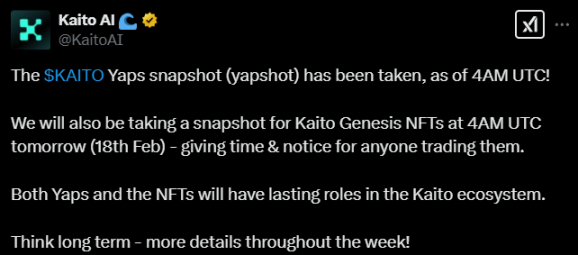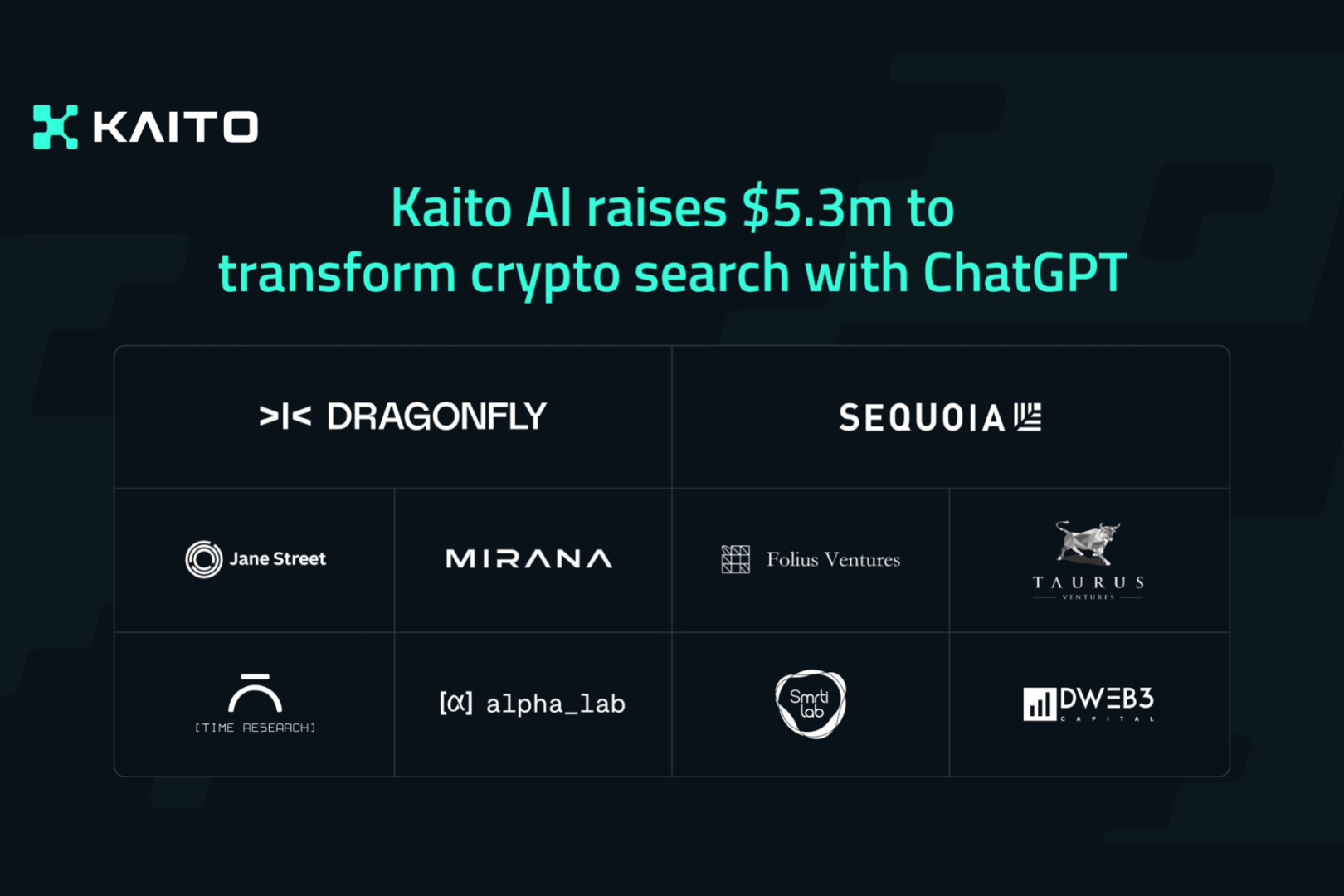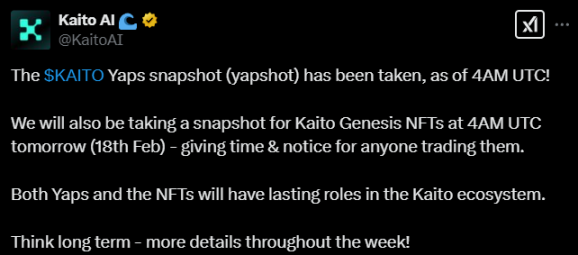Kaito AI is a Web3 search engine founded by a former Citadel quantitative trader.
Author: Luke, Mars Finance
introduction
On February 17, AI-backed Web3 search engine Kaito AI announced the completion of the KAITO Yaps snapshot, followed by the Genesis NFT snapshot. In this long-planned wealth dispatch, chain analyst Caneleo found that Kaito had deployed 1 billion tokens in the Base chain, 33.3% of which could be used for airdrops.

In other words, there are 333 million $KAITOs on the market that are about to be distributed to NFT holders and Yap contributors. Based on Kaito’s previous round of financing valuation of US$87.5 million, based on a 33.3% airdrop ratio, the theoretical total value of airdrops is close to US$28.875 million.
Among them, Kaito designed a double-deck airdrop system:
- Genesis NFT holders: 1500 NFTs will allocate 15% of the airdrop pool (approximately US$4.32 million), and a single NFT is expected to receive US$2880 in $KAITO;
- Yap contributors: The remaining 85%(US$24.555 million) is distributed in proportion to points. Combined with the current release speed, the value of each Yap is approximately US$13.
When the market realized the scale and return rate of the airdrop, FOMO sentiment quickly warmed up. The army of “hair-raising” from all walks of life frantically rushed to the standings. Kaito’s tweet was swiped on X (formerly Twitter), and a Web3 version of the “Airdrop Hunger Games” officially kicked off.
Why did Kaito quickly become the most high-profile airdrop project for Web3 after EigenLayer?
Valuation expectations ignite FOMO: Kaito valued it at US$87.5 million in its Series A financing in June 2023. Benchmarking Berachain’s post-financing valuation has increased by 8 times. If Kaito follows the same path, the value of the airdrop may be increased by 10 times.
Ecological leverage amplifies gains: Kaito adopts the “Yap to Earn”+”Genesis NFT” dual points system, and users who hold NFT may even receive airdrop rewards of more than US$13000.
Top venture capital support: Sequoia Capital, Dragonfly and other institutions entered the market to enhance project endorsements, and market confidence increased significantly.
Under the atmosphere of FOMO, Kaito is not only an AI search engine, but also like a Web3 rich volcano that is about to erupt.
Who is Kaito? — The “AI rainmaker” of the Web3 information empire
If EigenLayer is the hottest “liquidity re-pledge” project this year, Kaito is a pioneer in information finance (InfoFi), with its goal of becoming the Google + Bloomberg terminal of the crypto world.
Kaito was founded by former Citadel quantitative trader Yu Hu and focuses on solving the problem of information fragmentation in the Web3 world. Faced with massive amounts of scattered data such as Twitter, Discord, and governance forums, Kaito integrated it through the AI model to create MetaSearch, an intelligent search engine specifically tailored for crypto investors.
Different from traditional search engines, Kaito can not only index various data sources on Web3, but also combine ChatGPT technology to generate in-depth analysis, allowing investors to obtain market intelligence with one click and accurately capture Alpha opportunities on the chain. Therefore, Kaito is also known as the “Alpha Catcher of Web3.”

In the past two years, Kaito has performed well in the capital market and attracted the attention of top venture capitalists:
- Seed Round (February 2023): Led by Dragonfly, raised US$5.3 million and valued at US$40 million.
- Series A (June 2023): Led by Superscrypt and Spartan, it raised US$5.5 million and its valuation soared directly to US$87.5 million.
- Growth turning point (June 2024): Kaito announced its first profit, moving from a “burning money to a self-sufficient AI giant.
The capital injection of top venture capital not only means recognition of Kaito’s business model, but also further strengthens its ecological value and provides strong support for the future token economy model.
Kaito is not just a search engine, it also builds a complete information economy system. Through the “Yap to Earn” model, users can earn Yap points through the following methods:
- Content contribution: Post on Twitter, tag @KaitoAI, and share crypto market analysis.
- Social fission: Invite friends to participate and use multi-account tools (such as MoreLogin) to improve the efficiency of earning points.
- NFT Empowerment: Holding the Genesis NFT (cast price 0.1 ETH) can increase the weight of airdrops and even have the opportunity to earn token rewards of up to US$13000.
This mechanism directly converts information attention into assets on the chain, making Kaito not only a tool, but a platform that can “mine”.
Valuation Game: The Value Code of Airdrop Feast
During Kaito’s airdrop carnival, Yap points and Genesis NFT have become the focus of market attention, and discussions around their value have intensified. Multiple analytical models try to predict the reasonable valuation of Yap and NFT, and the conclusions under different assumptions have also gradually evolved market expectations from a rational game to a FOMO craze.
1. Capital-driven model: Theoretical extreme values derived from FDV formula
Valuations in the crypto market have always been based on narrative and capital flows, so the first model attempts to calculate the potential value of Yap directly based on Kaito’s future fully diluted valuation (FDV).
KOLRen_gmi adopts the formula of FDV × airdrop ratio/total circulation, assuming:
- Kaito’s FDV is US$1 billion;
- 30% of tokens are used for airdrops;
- Yapper plans to run for 90 days and release a total of 2.275 million Yaps.
On this basis, the model calculated that the value of Yap was US$131, far exceeding mainstream market expectations.
But this deduction has obvious flaws:
- Additional NFT airdrops are not taken into account, which may affect Yapper’s actual income;
- The assumption of total Yap supply is too ideal, and the actual circulation may be affected by factors such as listing on the exchange and the pace of issuance by the project party.
Despite this, the model still gives extreme values under optimistic market expectations, providing theoretical support for the attractiveness of Kaito airdrops.
2. NFT Voting Rights Model: The Game of Web3 Community Governance
Compared with pure FDV derivation, KOLDeFiTeddy2020 adopts an NFT voting rights model that is more in line with Kaito’s ecology.
In Kaito’s design, Genesis NFTs give holders a greater say in ecological governance, and these NFTs also have airdrop weight. Therefore, the model assumes:
- The market price of a single Genesis NFT is 9.3 ETH;
- The corresponding voting weight is 1162 Yaps;
Based on this calculation, the theoretical value of each Yap is about $22.
This method starts from the market pricing of NFT and attempts to establish a relative valuation relationship between Yap and NFT, but its limitations are:
- ETH price fluctuation risk, the market price of NFT itself may be affected by liquidity;
- The weight of voting rights does not necessarily directly reflect the value of the token, and the way governance power is assigned is not yet fully transparent.
Although the model yields values that are much lower than the FDV derivation method, it provides a new perspective on understanding Yap valuations from an NFT ecological perspective.
3. Competitor benchmarking model: Comparability between Kaito and Hyperliquid
In Web3 tracks, valuations often depend on how the market compares similar projects. KOLSteve_4P uses the method of comparing competing products and compares Kaito with Hyperliquid in an attempt to arrive at a valuation range that is more in line with market logic.
From the perspective of PMF (Product Market Fit):
- Hyperliquid: Optimize verified trading markets based on the mature decentralized exchange (DEX) model;
- Kaito: Exploring a new paradigm of information finance (InfoFi) has not yet formed a solid closed loop of market demand.
In terms of comparable valuations:
- Hyperliquid can benchmark against DEX such as dYdX and Drift, and the market awareness is relatively clear;
- Kaito currently has no direct competitors. The closest case may be Friend.tech, but the latter’s social financial model has major flaws.
Analysis from the perspective of token value capture:
- Hyperliquid has a clear token destruction mechanism to help maintain long-term value;
- Kaito’s income distribution mechanism has not yet been closed, and the value of its tokens is still highly uncertain.
Based on these factors, the model believes that Kaito token’s earnings expectations will not exceed Hyperliquid, so Yap’s valuation cap may be well below extreme forecasts in some markets.
4. Realistic valuation model: deriving market expectations based on financing data
Compared with theoretical deduction, the market prefers real data support. Kaito’s Series A financing is valued at US$87.5 million. Combined with the announced 33.3% token airdrop plan, we can derive a more reasonable value range:
- NFT valuation derivation: The total cost of 1500 Genesis NFTs is US$540,000. Based on the financing valuation enlarged by 8 times, the total airdrop is expected to be approximately US$4.32 million, and each NFT is approximately US$2880;
- Yap point valuation derivation: The remaining US$24.555 million will be allocated to Yap point holders. Based on the current release rate, 1 Yap is worth approximately US$13.
However, financing valuation is not the final market pricing, so the model further uses Story Protocol and Berachain as benchmarking objects to arrive at a reasonable set of market ranges:
- Story Protocol: The valuation is enlarged by 16 times. The current FDV is about US$1.73 billion. Based on its market performance, Kaito’s NFT may be worth US$2,218 – 2,880, and Yap is worth US$10 -13.
- Berachain: The financing valuation has been enlarged by eight times. The current FDV is about US$2.8 billion. If Kaito follows the same path, NFT may be airdropped worth US$5357 and Yap will be worth US$24.
Amid extreme FOMO sentiment in the market, Berachain’s highest FDV once reached US$6.75 billion. If Kaito follows this model, its NFT may surge to US$13000, and the value of Yap may surge to US$59.
Conclusion: Valuation variables and market enthusiasm
Summarizing the four models, we can see different possibilities for the value of Kaito airdrops:

In the end, the actual value of Kaito airdrops will depend on the following key factors:
- Market feedback after the launch of the tokens: If there is sufficient liquidity, the valuation may rise significantly;
- Long-term development strategy of the project party: If the InfoFi ecosystem can be closed, the value captured by tokens will be more stable;
- Evolution of market sentiment: The duration of the FOMO atmosphere will affect short-term value fluctuations.
What is certain is that Kaito is setting off a new airdrop storm in the crypto market, and how this storm will end will still require the market to give the answer itself.



